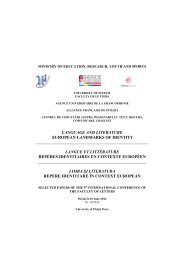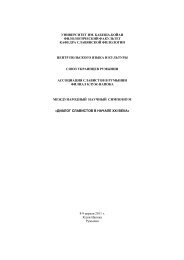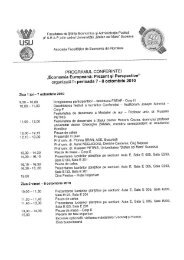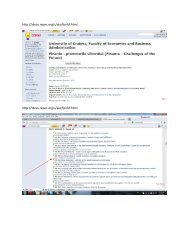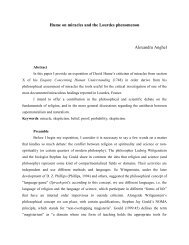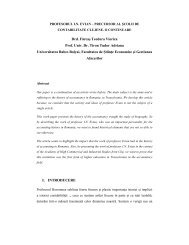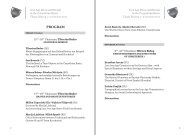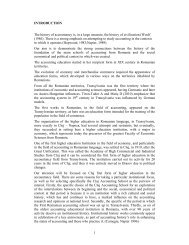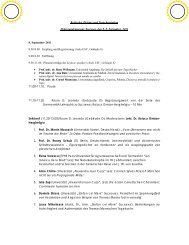challenges of the cross-border cooperation programmes at the ...
challenges of the cross-border cooperation programmes at the ...
challenges of the cross-border cooperation programmes at the ...
Create successful ePaper yourself
Turn your PDF publications into a flip-book with our unique Google optimized e-Paper software.
CHALLENGES OF THE CROSS-BORDER COOPERATION<br />
PROGRAMMES AT THE EASTERN BORDER OF THE EUROPEAN<br />
UNION<br />
Marcela ȘLUSARCIUC<br />
University ”Ștefan cel Mare”, Romania<br />
slusarciuc.marcela@usv.ro<br />
Abstract: The Joint Oper<strong>at</strong>ional Programmes, financed through <strong>the</strong> European Neighbourhood<br />
Partnership Instrument, are <strong>the</strong> financial tool th<strong>at</strong> put in practice <strong>the</strong> European Neighbourhood Policy with<br />
potential Eastern candid<strong>at</strong>e countries. The aim <strong>of</strong> <strong>the</strong> <strong>programmes</strong> is generous wishing to cre<strong>at</strong>e bridges<br />
between <strong>the</strong> partner st<strong>at</strong>es for sustaining <strong>the</strong> communities in <strong>the</strong> <strong>border</strong> areas in order to find common solutions<br />
to similar problems <strong>the</strong>y face. Through <strong>the</strong> <strong>programmes</strong>, <strong>the</strong> local authorities and <strong>the</strong> organiz<strong>at</strong>ions from <strong>the</strong><br />
<strong>border</strong> area are encouraged to cooper<strong>at</strong>e for <strong>the</strong> local economy development, common management <strong>of</strong><br />
environment issues or emergency situ<strong>at</strong>ions preparedness and not <strong>the</strong> last for a good interaction between <strong>the</strong><br />
<strong>border</strong> communities. The paper aims to explore wh<strong>at</strong> are <strong>the</strong> main <strong>challenges</strong> th<strong>at</strong> <strong>the</strong> applicants, beneficiaries<br />
and <strong>the</strong> institutions involved face and how <strong>the</strong>y affect reaching <strong>the</strong> aim <strong>of</strong> <strong>the</strong> programme.<br />
Keywords: <strong>cross</strong>-<strong>border</strong> <strong>cooper<strong>at</strong>ion</strong>, Eastern <strong>border</strong>, European Union, European Neighbourhood<br />
Partnership Instrument, Joint Oper<strong>at</strong>ional Programme (JOP).<br />
INTRODUCTION<br />
For 2007-2013 programming period it is in place <strong>the</strong> European Neighbourhood Partnership<br />
Instrument (ENPI) through which <strong>the</strong>re are financed three <strong>programmes</strong> on <strong>the</strong> actual Eastern <strong>border</strong> <strong>of</strong><br />
EU and covering mainly Ukraine and Republic <strong>of</strong> Moldova: Joint Oper<strong>at</strong>ional Programme Poland-<br />
Belarus-Ukraine, Joint Oper<strong>at</strong>ional Programme Hungary-Slovakia-Romania-Ukraine and Joint<br />
Oper<strong>at</strong>ional Programme Romania-Ukraine–Republic <strong>of</strong> Moldova. In <strong>the</strong> period 2007-2013 total<br />
funding under <strong>the</strong> ENPI CBC programme is expected to amount to some 1,118 million Euro, with<br />
around 527 million Euro coming from ENPI and <strong>the</strong> balance from ERDF funds.<br />
The main priorities <strong>of</strong> <strong>the</strong> above mentioned <strong>programmes</strong> are built around economic and social<br />
development, environment management and protection, increase <strong>of</strong> <strong>the</strong> security and efficiency <strong>of</strong> <strong>the</strong><br />
<strong>border</strong> by proper management and <strong>the</strong> “People to people” component (CBC Programme Pl-By-Ua,<br />
2008; CBC Programme Hu-Sk-Ro-Ua, 2008; JOP Ro-Ua-Md, 2008). The main applicants for all three<br />
<strong>programmes</strong>, with exceptions depending on <strong>the</strong> specificity <strong>of</strong> <strong>the</strong> participant countries in <strong>the</strong><br />
programme, are <strong>the</strong> public administr<strong>at</strong>ion – regional and local authorities, non-governmental/ nonpr<strong>of</strong>it<br />
organiz<strong>at</strong>ions or o<strong>the</strong>r institutions such as universities, chambers <strong>of</strong> commerce, business nonpr<strong>of</strong>it<br />
associ<strong>at</strong>ions or o<strong>the</strong>rs. One <strong>of</strong> <strong>the</strong> most important specificities <strong>of</strong> those <strong>programmes</strong> is th<strong>at</strong> <strong>the</strong><br />
partnership a<strong>cross</strong> countries is mand<strong>at</strong>ory and <strong>at</strong> least one partner from <strong>the</strong> Member St<strong>at</strong>e has to be<br />
included in <strong>the</strong> project. This issue is <strong>the</strong> engine <strong>of</strong> <strong>the</strong> <strong>cross</strong> <strong>border</strong> partnership along <strong>the</strong> Eastern <strong>border</strong><br />
and it helps for <strong>the</strong> know-how transfer from <strong>the</strong> EU to <strong>the</strong> partner countries in <strong>the</strong> aspects <strong>of</strong> project<br />
management.<br />
In case <strong>of</strong> this ENPI programme, <strong>the</strong> Joint Managing Authority (JMA) shall bear <strong>the</strong> overall<br />
responsibility for <strong>the</strong> management and implement<strong>at</strong>ion <strong>of</strong> <strong>the</strong> programme towards <strong>the</strong> European<br />
Commission, while <strong>the</strong> beneficiary is responsible to <strong>the</strong> JMA and is directly accountable to <strong>the</strong>
authority for <strong>the</strong> oper<strong>at</strong>ional and financial progress <strong>of</strong> activities. The legal basis for <strong>the</strong>se <strong>programmes</strong><br />
implement<strong>at</strong>ion consists <strong>of</strong> Regul<strong>at</strong>ion 1638/2006 <strong>of</strong> <strong>the</strong> European Parliament and <strong>of</strong> <strong>the</strong> Council <strong>of</strong> 24<br />
October 2006 laying down general provisions establishing a European Neighbourhood and Partnership<br />
Instrument, Commission Regul<strong>at</strong>ion no 951/2007 laying down implementing rules for <strong>cross</strong><strong>border</strong><br />
<strong>cooper<strong>at</strong>ion</strong> <strong>programmes</strong> financed under Regul<strong>at</strong>ion no 1638/2006 <strong>of</strong> <strong>the</strong> European Parliament and <strong>of</strong><br />
<strong>the</strong> Council <strong>of</strong> 24 October 2006 laying down general provisions establishing a European<br />
Neighbourhood and Partnership Instrument, usually named Implementing Rules. The contractual<br />
procedures used for implement<strong>at</strong>ion <strong>of</strong> <strong>the</strong> <strong>programmes</strong> shall be those applicable to external actions as<br />
defined in Articles 162 to 170 <strong>of</strong> Council Regul<strong>at</strong>ion no 1605/2002 and Articles 231 to 256 <strong>of</strong> <strong>the</strong><br />
Commission Regul<strong>at</strong>ion no 2342/2002. The procedures and rel<strong>at</strong>ed standard documents and contract<br />
templ<strong>at</strong>es to be used are those included in <strong>the</strong> Practical Guide to contract procedures for EC external<br />
actions with annexes in force <strong>at</strong> <strong>the</strong> time <strong>of</strong> <strong>the</strong> launching <strong>of</strong> procurement procedures or call for<br />
proposals.<br />
1. THE EXPERIENCE OF THE JOINT TECHNICAL SECRETARIATS<br />
Inhere I made a compar<strong>at</strong>ive qualit<strong>at</strong>ive research between three JOPs th<strong>at</strong> are situ<strong>at</strong>ed <strong>at</strong> <strong>the</strong><br />
Eastern <strong>border</strong> <strong>of</strong> EU and include Ukraine and/or Republic <strong>of</strong> Moldova. The tool used was <strong>the</strong><br />
interview applied to one <strong>of</strong> <strong>the</strong> programme structures, namely Joint Technical Secretari<strong>at</strong>, which is <strong>the</strong><br />
body th<strong>at</strong> links <strong>the</strong> decisional bodies – Joint Managing Authority and Joint Monitoring Committee, and<br />
<strong>the</strong> beneficiaries.<br />
This section makes a summary <strong>of</strong> <strong>the</strong> research findings concerning <strong>the</strong> good fe<strong>at</strong>ures th<strong>at</strong> actual<br />
Joint Oper<strong>at</strong>ional Programmes have and <strong>the</strong> lessons learned by <strong>the</strong> executive bodies involved in <strong>the</strong><br />
<strong>programmes</strong> implement<strong>at</strong>ion as a link between <strong>the</strong> Joint Managing Authorities and Joint Monitoring<br />
Committees, as decisional and str<strong>at</strong>egic structures, and <strong>the</strong> beneficiaries, as project implementers and<br />
grant users. The findings are structured by relevant fields and combine <strong>the</strong> interviews with <strong>the</strong> Heads <strong>of</strong><br />
<strong>the</strong> JTSs from <strong>the</strong> three JOP from <strong>the</strong> Eastern <strong>border</strong> <strong>of</strong> <strong>the</strong> EU th<strong>at</strong> includes Ukraine and Republic <strong>of</strong><br />
Moldova.<br />
1.1. Challenges, solutions and starting points<br />
1.1.1. Programming<br />
Practical Guide (PRAG, yearly versions), in <strong>the</strong> form it is now, it is not fitting to this kind <strong>of</strong><br />
<strong>programmes</strong> and needs improvements. From legal perspective <strong>the</strong> most critical part <strong>of</strong> this programme<br />
is <strong>the</strong> whole composition <strong>of</strong> <strong>the</strong> <strong>programmes</strong> th<strong>at</strong> have 3 or more countries, <strong>the</strong> problem being <strong>the</strong><br />
regul<strong>at</strong>ion and <strong>the</strong> basic act, meaning PRAG th<strong>at</strong> is outd<strong>at</strong>ed. The PRAG sets <strong>the</strong> rules between EC and<br />
<strong>the</strong> countries, but in <strong>the</strong> frame <strong>of</strong> <strong>the</strong> tril<strong>at</strong>eral or quadril<strong>at</strong>eral programme because <strong>the</strong> legal connection<br />
between <strong>the</strong> partner and <strong>the</strong> beneficiary was never set. The proposal is th<strong>at</strong> for a next programme not to<br />
apply <strong>at</strong> all <strong>the</strong> PRAG rules. There is experience from ERDF, IPA th<strong>at</strong> became ETC rules also <strong>the</strong>re is<br />
a base for cre<strong>at</strong>ing new specific rules for <strong>cross</strong><strong>border</strong> <strong>programmes</strong> with partner countries.<br />
Ano<strong>the</strong>r issue linked to this is <strong>the</strong> situ<strong>at</strong>ion <strong>of</strong> JMC th<strong>at</strong> has to decide about <strong>the</strong> selected projects<br />
after <strong>the</strong> recommend<strong>at</strong>ion <strong>of</strong> <strong>the</strong> Evalu<strong>at</strong>ion Committees. In case th<strong>at</strong> JMC wants to make modific<strong>at</strong>ions<br />
on <strong>the</strong> recommend<strong>at</strong>ion <strong>the</strong>re is need <strong>the</strong> approval <strong>of</strong> EC, fact th<strong>at</strong> cre<strong>at</strong>es <strong>the</strong> situ<strong>at</strong>ion when <strong>the</strong> JMC
as <strong>the</strong> highest decisional body cannot decide alone on <strong>the</strong> m<strong>at</strong>ters th<strong>at</strong> are in its area. This aspect should<br />
be deleted from <strong>the</strong> system.<br />
From <strong>the</strong> point <strong>of</strong> view <strong>of</strong> <strong>the</strong> programming process it is better to concentr<strong>at</strong>e on <strong>the</strong> people living<br />
on <strong>the</strong> territory and not to have a central guide because we need to know wh<strong>at</strong> is are interests <strong>of</strong> <strong>the</strong><br />
countries.<br />
The <strong>programmes</strong>’ objectives are too wide also almost any kind <strong>of</strong> project can fit in it and as<br />
consequence, if it would be drawn a line <strong>at</strong> <strong>the</strong> end <strong>of</strong> <strong>the</strong> programme with <strong>the</strong> purpose <strong>of</strong> measuring<br />
impact or results, this cannot be realized. Proper would be a more specific approach, based on studies<br />
about <strong>the</strong> programme area and <strong>the</strong> formul<strong>at</strong>ion <strong>of</strong> more targeted objectives as well as after seven years<br />
<strong>of</strong> programme to be possible to conclude wh<strong>at</strong> needs were covered from <strong>the</strong> programme, entirely or<br />
partially.<br />
As far as concerns <strong>the</strong> consult<strong>at</strong>ion <strong>of</strong> <strong>the</strong> local actors, for <strong>the</strong> actual programme <strong>the</strong>re is possible<br />
th<strong>at</strong> it was not system<strong>at</strong>ic, respectively only 2-3 workshops, with low possibility <strong>of</strong> a clear analysis <strong>of</strong><br />
needs. The needs analysis should start from <strong>the</strong> analysis <strong>of</strong> <strong>the</strong> development str<strong>at</strong>egies <strong>of</strong> <strong>the</strong><br />
communities a<strong>cross</strong> <strong>the</strong> <strong>border</strong>s and to identify <strong>the</strong> common points <strong>of</strong> interest.<br />
ENPI allows <strong>the</strong> <strong>programmes</strong> to choose <strong>the</strong> type <strong>of</strong> projects, namely simple, integr<strong>at</strong>ed or<br />
symmetric, but <strong>the</strong> simple projects are not relevant anymore in <strong>cross</strong><strong>border</strong> context. This is an issue th<strong>at</strong><br />
should be analyzed and it should be established how much such projects are still necessary. A simple<br />
project is easy to manage, being understood <strong>the</strong> applicants’ appetency for this kind <strong>of</strong> projects, but from<br />
<strong>the</strong> point <strong>of</strong> view <strong>of</strong> partnership and <strong>cross</strong><strong>border</strong> impact it is not significant.<br />
1.1.2. Calls for proposals<br />
The actual frame is good, with project management training session and inform<strong>at</strong>ion sessions <strong>at</strong><br />
n<strong>at</strong>ional level delivered by <strong>the</strong> JTS. There is welcomed <strong>the</strong> particip<strong>at</strong>ion <strong>of</strong> Interact or RCBI in <strong>the</strong><br />
delivering <strong>of</strong> <strong>the</strong>se sessions due to <strong>the</strong>ir horizontal inform<strong>at</strong>ion level, being involved in more<br />
<strong>programmes</strong> and more countries. The BOs have a very limited role due to <strong>the</strong> implementing rules<br />
provisions, having tasks about organiz<strong>at</strong>ion mainly. The number <strong>of</strong> events is less important than <strong>the</strong><br />
quality and consistency <strong>of</strong> <strong>the</strong> inform<strong>at</strong>ion delivered.<br />
The positive aspects are referring to a higher clarity about <strong>the</strong> programme requirements as well as<br />
<strong>the</strong> potential applicants to understand wh<strong>at</strong> <strong>the</strong> programme aims and wh<strong>at</strong> <strong>the</strong>y have to do <strong>at</strong> each step<br />
in order to apply. The first call for proposals had evasive and interpretable th<strong>at</strong> gener<strong>at</strong>ed frustr<strong>at</strong>ions<br />
and appeals, but <strong>the</strong> second call tried to fix this making <strong>the</strong> guidelines more friendly and concise, with<br />
clearer issues. Also, <strong>the</strong> clarity is an aspect to be considered in a following programme.<br />
The evalu<strong>at</strong>ion process was better described in <strong>the</strong> second call for proposals in case <strong>of</strong> some<br />
<strong>programmes</strong> and <strong>the</strong> applicants knew better <strong>the</strong> situ<strong>at</strong>ions for rejecting a project and <strong>the</strong> appeal<br />
procedure was established making <strong>the</strong> process more transparent compared with <strong>the</strong> first call for<br />
proposals.<br />
Some provisions <strong>of</strong> <strong>the</strong> guidelines are too strict because it turned out th<strong>at</strong> in <strong>the</strong> end <strong>the</strong>re were<br />
many good projects th<strong>at</strong> were rejected because <strong>of</strong> not complying with <strong>the</strong> administr<strong>at</strong>ive eligibility<br />
check. This is 1-0 option, for example one <strong>of</strong> <strong>the</strong> annexes is not submitted.<br />
Wh<strong>at</strong> is missing in <strong>the</strong> programme but it cannot be solved during a call for proposals are <strong>the</strong><br />
projects for increasing <strong>the</strong> capacity <strong>of</strong> <strong>the</strong> potential applicants, mainly <strong>the</strong> ones from <strong>the</strong> partner<br />
countries, about <strong>the</strong> project management frame (for example <strong>the</strong> principles, <strong>the</strong> concept <strong>of</strong> relevance,<br />
<strong>the</strong> planning <strong>of</strong> <strong>the</strong> indic<strong>at</strong>ors and <strong>the</strong> activities, etc.). This type <strong>of</strong> training should be delivered all along<br />
<strong>the</strong> programme period and not only during <strong>the</strong> call for proposals.
It would be more useful an applic<strong>at</strong>ion form with simpler form<strong>at</strong>, easier to understand and fill by<br />
<strong>the</strong> applicants. There are sections in <strong>the</strong> applic<strong>at</strong>ion form about relevance or coherence with <strong>the</strong><br />
programme objectives th<strong>at</strong> are very summary described, <strong>the</strong> space available for <strong>the</strong>se sections being<br />
restrained while for o<strong>the</strong>r sections is more generous, even if in <strong>the</strong> implement<strong>at</strong>ion stage <strong>the</strong> details<br />
from <strong>the</strong>e sections are not entirely useful. There is need for more space for issues like relevance,<br />
<strong>cross</strong><strong>border</strong> impact, sustainability, internal monitoring and control mechanism and less pace for<br />
methodology as example.<br />
1.1.3. Assessment <strong>of</strong> <strong>the</strong> applic<strong>at</strong>ions<br />
The system <strong>of</strong> restricted call for proposals used in some calls for proposals is it one to be<br />
considered in a next programme, namely <strong>the</strong> initial submission <strong>of</strong> a concept note, <strong>the</strong> selection and a<br />
provisionally list <strong>of</strong> applicants, <strong>the</strong> preparing <strong>of</strong> a full applic<strong>at</strong>ion and <strong>the</strong> final selection <strong>of</strong> <strong>the</strong> projects.<br />
The advantages <strong>of</strong> this system are about <strong>the</strong> shortening <strong>of</strong> time needed for applicants to prepare a preproposal,<br />
in case <strong>of</strong> big projects <strong>the</strong> request for submission <strong>of</strong> <strong>the</strong> full applic<strong>at</strong>ion being expensive and<br />
with a high volume <strong>of</strong> documents. In case <strong>of</strong> <strong>the</strong> restricted call <strong>the</strong>se costs are occurring only after <strong>the</strong><br />
applicant is on a provisional short list. Ano<strong>the</strong>r advantage is <strong>the</strong> decrease <strong>of</strong> <strong>the</strong> time needed for<br />
evalu<strong>at</strong>ion especially in case <strong>of</strong> a significant high number <strong>of</strong> applic<strong>at</strong>ions.<br />
A good aspect is th<strong>at</strong> <strong>the</strong> programme allows th<strong>at</strong> <strong>the</strong> score awarded in <strong>the</strong> assessment <strong>of</strong> <strong>the</strong><br />
concept note for <strong>the</strong> relevance issue is considered in <strong>the</strong> assessment <strong>of</strong> <strong>the</strong> full applic<strong>at</strong>ion with no<br />
changes.<br />
Ano<strong>the</strong>r positive aspect is th<strong>at</strong> <strong>the</strong>re is an appeal procedure th<strong>at</strong> is allowed in any evalu<strong>at</strong>ion step<br />
and due to its specificity eases a prompt answer from <strong>the</strong> programme management structures. The<br />
clarity <strong>of</strong> <strong>the</strong> guidelines provisions in this m<strong>at</strong>ter lead to a lower number <strong>of</strong> appeals compared with <strong>the</strong><br />
previous evalu<strong>at</strong>ion process.<br />
It is advisable to use <strong>the</strong> same evalu<strong>at</strong>ion system as in this programme, namely an evalu<strong>at</strong>ion<br />
committee for each priority, committees with a lower number <strong>of</strong> evalu<strong>at</strong>ors, one represent<strong>at</strong>ive per<br />
country, this formula having good results and an easier consensus building process. There are voices<br />
among <strong>the</strong> regional actors th<strong>at</strong> propose th<strong>at</strong> each country should assess its own applic<strong>at</strong>ions but this<br />
approach it is not a desired one considering <strong>the</strong> projects specificity, with partnership in <strong>the</strong> o<strong>the</strong>r<br />
countries. Moreover, it is difficult to keep <strong>the</strong> <strong>cross</strong><strong>border</strong> character in <strong>the</strong> situ<strong>at</strong>ion th<strong>at</strong> each country<br />
will receive a part <strong>of</strong> <strong>the</strong> budget and will assess separ<strong>at</strong>ely <strong>the</strong> own applic<strong>at</strong>ions. It is possible th<strong>at</strong><br />
following <strong>the</strong> assessment to have a selection <strong>of</strong> relevant projects for <strong>the</strong> regions from th<strong>at</strong> country but<br />
not necessarily relevant for <strong>the</strong> partner from <strong>the</strong> o<strong>the</strong>r side <strong>of</strong> <strong>the</strong> <strong>border</strong>. Also <strong>the</strong>re is <strong>the</strong> issue <strong>of</strong><br />
conflict <strong>of</strong> interests in <strong>the</strong> situ<strong>at</strong>ion <strong>of</strong> n<strong>at</strong>ional assessment, considering th<strong>at</strong> it should be <strong>the</strong> certitude<br />
th<strong>at</strong> <strong>the</strong> ones involved in <strong>the</strong> evalu<strong>at</strong>ion process have no personal interest on <strong>the</strong> proposed projects.<br />
Ano<strong>the</strong>r aspect th<strong>at</strong> should be transferred fur<strong>the</strong>r is <strong>the</strong> award <strong>of</strong> incentives for <strong>the</strong> particip<strong>at</strong>ion <strong>of</strong><br />
<strong>the</strong> partner countries, for example to encourage <strong>the</strong> tril<strong>at</strong>eral partnerships or <strong>the</strong> alloc<strong>at</strong>ion <strong>of</strong> <strong>the</strong> budget<br />
in <strong>the</strong> partner countries from a certain percentage, aiming a higher involvement in <strong>the</strong> programme <strong>of</strong><br />
<strong>the</strong> partner countries.<br />
It is good to c<strong>at</strong>ch up <strong>the</strong> setting up <strong>of</strong> more clear criteria for measuring <strong>the</strong> <strong>cross</strong><strong>border</strong><br />
partnership for ensuring its contain and <strong>the</strong> oblig<strong>at</strong>ion <strong>of</strong> respecting <strong>at</strong> least two out <strong>of</strong> four criteria:<br />
joint programming, joint implementing, joint financing and joint staffing. This improvement risen in<br />
<strong>the</strong> second call for proposals due to <strong>the</strong> fact th<strong>at</strong> in <strong>the</strong> first call for proposals <strong>the</strong>re were many projects<br />
with <strong>the</strong> budget managed by only one partner, <strong>the</strong> o<strong>the</strong>r partner being just formally involved, without a<br />
significant contribution.
When about <strong>the</strong> quality assessment <strong>the</strong>re are assessors, both internal and external JTS th<strong>at</strong> were<br />
approved within <strong>the</strong> open call for assessors and <strong>the</strong>re are opinions about <strong>the</strong> work <strong>of</strong> external assessors<br />
as not being s<strong>at</strong>isfactory, especially about <strong>the</strong> quality or <strong>the</strong> comments <strong>the</strong>y put in <strong>the</strong> evalu<strong>at</strong>ion grids.<br />
Even if it was provided training for <strong>the</strong>m still <strong>the</strong> work conducted by <strong>the</strong> external assessors was not<br />
good enough. Often <strong>the</strong>se comments were not in line with <strong>the</strong> project or with <strong>the</strong> assessment, so some<br />
problems in this case were faced. There is a good point from transparency point <strong>of</strong> view to involve JTS<br />
in <strong>the</strong> quality assessment <strong>of</strong> proposals, now <strong>the</strong> proposals being evalu<strong>at</strong>ed by independent assessors<br />
selected by open call. There is difficult to check <strong>the</strong> harmoniz<strong>at</strong>ion <strong>of</strong> <strong>the</strong> comments <strong>of</strong> <strong>the</strong> assessors<br />
with <strong>the</strong> points given having in mind <strong>the</strong> differences in cultures and fields.<br />
1.1.4. Implement<strong>at</strong>ion<br />
There are <strong>the</strong> procurements problem and <strong>the</strong> rule <strong>of</strong> origin problem in Poland because if <strong>the</strong>re are<br />
considered strictly <strong>the</strong> provisions in rel<strong>at</strong>ion to <strong>the</strong> procurement rules it cannot be imposed in <strong>the</strong> Polish<br />
tendering document<strong>at</strong>ion th<strong>at</strong> <strong>the</strong> goods must be bought only from <strong>the</strong> specified area. The n<strong>at</strong>ional<br />
legisl<strong>at</strong>ion has not provisions about it and <strong>the</strong>re are problems here also.<br />
In <strong>the</strong> implement<strong>at</strong>ion many o<strong>the</strong>r problems occurred in terms <strong>of</strong> procurement in case <strong>of</strong> Ukraine<br />
and Belarus where <strong>the</strong>re is <strong>the</strong> Annex IV th<strong>at</strong> says “<strong>the</strong> best intern<strong>at</strong>ional rules” meaning PRAG. The<br />
NGOs in Ukraine can use PRAG without any problems but <strong>the</strong> public entities are obliged to apply <strong>the</strong>ir<br />
n<strong>at</strong>ional procurement rules. There is <strong>the</strong> m<strong>at</strong>rix elabor<strong>at</strong>ed by Interact th<strong>at</strong> compares n<strong>at</strong>ional rules with<br />
PRAG but still it is an advisory tool for beneficiaries th<strong>at</strong> can be taken into consider<strong>at</strong>ion, <strong>the</strong>re are not<br />
provisions th<strong>at</strong> <strong>the</strong> m<strong>at</strong>rix must be followed.<br />
There are more rules regarding <strong>the</strong> implement<strong>at</strong>ion – <strong>the</strong> description <strong>of</strong> <strong>the</strong> management and<br />
control structure th<strong>at</strong> is coming from ETC rules and involves n<strong>at</strong>ional control structures in <strong>the</strong> three<br />
member st<strong>at</strong>es enforced by n<strong>at</strong>ional decrees, PRAG rules, horizontal regul<strong>at</strong>ions and <strong>the</strong> EC<br />
regul<strong>at</strong>ions. The harmoniz<strong>at</strong>ion <strong>of</strong> those is impossible regarding <strong>the</strong> procurements or o<strong>the</strong>r<br />
implement<strong>at</strong>ion issues and for example <strong>the</strong> EC never st<strong>at</strong>ed how <strong>the</strong> PRAG can be applied by <strong>the</strong><br />
bodies th<strong>at</strong> are not government rel<strong>at</strong>ed. There is a m<strong>at</strong>rix realized by Interact regarding <strong>the</strong> procurement<br />
in <strong>the</strong> partner countries and it was <strong>the</strong> desire <strong>of</strong> approval <strong>of</strong> it but by now it is not an <strong>of</strong>ficial document.<br />
The problem is th<strong>at</strong> between <strong>the</strong> n<strong>at</strong>ional legisl<strong>at</strong>ion in <strong>the</strong> partner countries and <strong>the</strong> PRAG <strong>the</strong>re are<br />
some gaps th<strong>at</strong> should be somehow solved but <strong>the</strong>re is no answer to it by now. Even if <strong>the</strong> Interact<br />
m<strong>at</strong>rix is not mand<strong>at</strong>ory it is useful and guiding for <strong>the</strong> partner countries.<br />
The specificity <strong>of</strong> <strong>the</strong> quadril<strong>at</strong>eral <strong>programmes</strong> is th<strong>at</strong> <strong>the</strong>re are three member st<strong>at</strong>es involved and<br />
<strong>the</strong> n<strong>at</strong>ional rules applied are different concerning <strong>the</strong> verific<strong>at</strong>ion <strong>of</strong> expenditures but on <strong>the</strong> o<strong>the</strong>r side<br />
<strong>the</strong>re is <strong>the</strong> JTS th<strong>at</strong> has to control everything. Moreover <strong>the</strong> JTS takes <strong>the</strong> final decision about <strong>the</strong><br />
eligibility <strong>of</strong> <strong>the</strong> expenditures but <strong>the</strong> opinion is formed based on reports <strong>of</strong> <strong>the</strong> n<strong>at</strong>ional controllers or<br />
independent auditors, for <strong>the</strong> partner country, without having <strong>the</strong> supporting documents as invoices or<br />
o<strong>the</strong>r pro<strong>of</strong>s. Also, <strong>the</strong> decision <strong>of</strong> <strong>the</strong> JTS concerning <strong>the</strong> eligibility <strong>of</strong> <strong>the</strong> expenditures incurred<br />
implies mainly <strong>the</strong> acceptance <strong>of</strong> <strong>the</strong> findings <strong>of</strong> <strong>the</strong> n<strong>at</strong>ional controllers or auditors and in case <strong>of</strong><br />
doubts to ask clarific<strong>at</strong>ion or supplementary documents, aspect th<strong>at</strong> makes <strong>the</strong> decision process longer.<br />
The final level <strong>of</strong> control is JTS and th<strong>at</strong> is why <strong>the</strong> ‘four eyes principle’ is applied very carefully and<br />
<strong>the</strong> structure <strong>of</strong> JTS is using <strong>the</strong> oper<strong>at</strong>ional part and <strong>the</strong> financial part <strong>of</strong> verific<strong>at</strong>ion leading to a kind<br />
<strong>of</strong> ‘ten eye principle’. Overall this means a huge amount <strong>of</strong> work and responsibility and, if it would be<br />
an optimum structure, this should be based on an increased responsibility on <strong>the</strong> partner countries th<strong>at</strong><br />
are signing a memorandum anyway with <strong>the</strong> JMA.
One <strong>of</strong> <strong>the</strong> biggest problems <strong>of</strong> <strong>the</strong> programme is LSPs, not <strong>the</strong> projects <strong>the</strong>mselves but <strong>the</strong> direct<br />
award procedure which is good for <strong>the</strong> countries and <strong>the</strong> JMA but from <strong>the</strong> management point <strong>of</strong> view<br />
is a nightmare. It is critical because <strong>of</strong> <strong>the</strong> value <strong>of</strong> <strong>the</strong>se projects, almost a third from <strong>the</strong> whole<br />
programme, and because <strong>of</strong> <strong>the</strong> technical complex aspects <strong>of</strong> <strong>the</strong>se projects, and in case th<strong>at</strong> <strong>the</strong>re are<br />
l<strong>at</strong>e contracted <strong>the</strong>re are risks concerning <strong>the</strong> financial and technical aspects. There is a much effort put<br />
in <strong>the</strong> promotion <strong>of</strong> <strong>the</strong>se projects but because <strong>the</strong>re are cooper<strong>at</strong>ing public institutions with big<br />
hierarchy from different countries <strong>the</strong>re are delays because <strong>the</strong>re are many steps from <strong>the</strong> first meeting<br />
till <strong>the</strong> setup <strong>of</strong> <strong>the</strong> project and <strong>the</strong>re are involved both kinds <strong>of</strong> people, <strong>the</strong> ones who make <strong>the</strong><br />
decisions and <strong>the</strong> ones who know <strong>the</strong> technical aspects and details for a better shape <strong>of</strong> <strong>the</strong> project and<br />
not all <strong>the</strong> time <strong>the</strong>y are available in <strong>the</strong> same time from all <strong>the</strong> partner countries.<br />
The implement<strong>at</strong>ion step is not described <strong>at</strong> <strong>the</strong> programme level being presented only general<br />
guiding lines and behind <strong>the</strong>se being necessary a big and meticulous effort for establishing <strong>the</strong> details,<br />
mainly <strong>the</strong> JTS sustaining this effort. The implement<strong>at</strong>ion rules for <strong>the</strong> project were set up long after<br />
<strong>the</strong> programme launch and <strong>the</strong>re will be a good aspect to be established an implement<strong>at</strong>ion str<strong>at</strong>egy<br />
right from <strong>the</strong> beginning <strong>of</strong> programming <strong>the</strong> JOP. It is good for <strong>the</strong> applicants also to know all <strong>the</strong>se<br />
details for a proper prepar<strong>at</strong>ion <strong>of</strong> <strong>the</strong> applic<strong>at</strong>ions.<br />
An issue th<strong>at</strong> should be analyzed and determined carefully is <strong>the</strong> share <strong>of</strong> responsibilities among<br />
<strong>the</strong> programme structures to avoid <strong>the</strong> overlapping th<strong>at</strong> would mean doubled activities and lack <strong>of</strong><br />
efficiency. An example is <strong>the</strong> one <strong>of</strong> <strong>the</strong> submitted beneficiaries’ reports th<strong>at</strong> are checked by three<br />
levels (FLC, JTS, JMA).<br />
1.2. Institutional systems <strong>of</strong> Joint Oper<strong>at</strong>ional Programmes<br />
Compared with <strong>the</strong> beginning <strong>of</strong> <strong>the</strong> programme <strong>the</strong> things are different. Many decisions are<br />
taken by written procedure, both on <strong>the</strong> JMC level and even <strong>at</strong> <strong>the</strong> Evalu<strong>at</strong>ion Committee also <strong>the</strong><br />
written procedures definitely improved <strong>the</strong> process <strong>of</strong> decision-making. The branch <strong>of</strong>fices (BO) are<br />
good, in <strong>the</strong> partner countries. In order to communic<strong>at</strong>e with <strong>the</strong> N<strong>at</strong>ional Authorities <strong>the</strong> JTS is<br />
contacting directly or through JMA, it depends on <strong>the</strong> issue. The work <strong>of</strong> branch <strong>of</strong>fices is appreci<strong>at</strong>ed<br />
especially when <strong>the</strong>re are <strong>the</strong> JMC meetings, in all <strong>the</strong> logistics, invit<strong>at</strong>ions, etc. They are set up just for<br />
<strong>the</strong> inform<strong>at</strong>ion and communic<strong>at</strong>ion purposes and <strong>the</strong> JOP has provisions about th<strong>at</strong> <strong>the</strong>y can help with<br />
<strong>the</strong> evalu<strong>at</strong>ion <strong>of</strong> <strong>the</strong> projects.<br />
At <strong>the</strong> actual moment in <strong>the</strong> JOP <strong>the</strong>re are many responsibilities defined for <strong>the</strong> JMA and several<br />
for <strong>the</strong> JTS and most <strong>of</strong> <strong>the</strong> tasks belonging to JMA are transferred to <strong>the</strong> JTS. From a point <strong>of</strong> view it<br />
is a good thing as long as <strong>the</strong> people working in <strong>the</strong> JTS are qualified and highly pr<strong>of</strong>essional. But on<br />
<strong>the</strong> o<strong>the</strong>r side people working in o<strong>the</strong>r structures <strong>of</strong> <strong>the</strong> programme are civil servants and sometimes<br />
<strong>the</strong>y don’t have a very high level <strong>of</strong> expertise. A proposal would be to have in all <strong>the</strong> programme<br />
structures people with a similar expertize in order to help to understand each o<strong>the</strong>r in a common<br />
language and field. A good aspect is th<strong>at</strong> <strong>the</strong> collabor<strong>at</strong>ion between <strong>the</strong> JTS and <strong>the</strong> NAs is good<br />
mainly due to <strong>the</strong> fact th<strong>at</strong> inside JTS are working people coming from all <strong>the</strong> programme countries<br />
also <strong>the</strong> beneficiaries and <strong>the</strong> n<strong>at</strong>ional structures <strong>of</strong> <strong>the</strong> programme can talk with <strong>the</strong> pr<strong>of</strong>essional<br />
people from JTS in <strong>the</strong>ir own language and <strong>the</strong> communic<strong>at</strong>ion is better. Even if <strong>the</strong> language <strong>of</strong> <strong>the</strong><br />
programme is English it is not <strong>of</strong>ten in <strong>the</strong> real life th<strong>at</strong> a person involved in a project, coming from a<br />
smaller village, can be experienced in legal terms in English.<br />
JMC has a str<strong>at</strong>egic role in <strong>the</strong> programme but <strong>the</strong> direct intervention in <strong>the</strong> programme should be<br />
clear about <strong>the</strong> selection and approval <strong>of</strong> <strong>the</strong> projects list recommended for grant, decisions rel<strong>at</strong>ed to<br />
<strong>the</strong> financial alloc<strong>at</strong>ions, decisions rel<strong>at</strong>ed to <strong>the</strong> conditions <strong>of</strong> <strong>the</strong> call for proposals, meaning
exclusively aspects <strong>of</strong> str<strong>at</strong>egic level <strong>of</strong> decision. The main responsibility about <strong>the</strong> programme<br />
implement<strong>at</strong>ion should be design<strong>at</strong>ed to JMA and <strong>the</strong> NAs should give a higher support to <strong>the</strong> JMA in<br />
wh<strong>at</strong> supposes <strong>the</strong> implement<strong>at</strong>ion <strong>of</strong> <strong>the</strong> programme, namely providing inform<strong>at</strong>ion concerning some<br />
specific n<strong>at</strong>ional issues, for example <strong>the</strong> level <strong>of</strong> harmoniz<strong>at</strong>ion <strong>of</strong> <strong>the</strong> n<strong>at</strong>ional legisl<strong>at</strong>ion with <strong>the</strong> EU<br />
legisl<strong>at</strong>ion or <strong>the</strong> conditions <strong>of</strong> issuing a building permit in <strong>the</strong> partner countries. There is a need for<br />
clearer distribution <strong>of</strong> responsibilities and tasks between <strong>the</strong> JMA as superior level and JTS as a level<br />
near to <strong>the</strong> beneficiaries, JTS being mostly an executive body and in some situ<strong>at</strong>ions is necessary to be<br />
more involved in <strong>the</strong> management <strong>of</strong> <strong>the</strong> programme.<br />
1.3. The decisional process <strong>of</strong> <strong>the</strong> <strong>programmes</strong><br />
In aspects concerning <strong>the</strong> institutional and decisional-making process, <strong>the</strong>re is <strong>the</strong> aim <strong>of</strong> <strong>the</strong><br />
Commission <strong>of</strong> having <strong>the</strong> so called ‘shared management’ th<strong>at</strong> should be implemented. During <strong>the</strong><br />
evalu<strong>at</strong>ion <strong>of</strong> <strong>the</strong> projects <strong>the</strong>re were many problems in rel<strong>at</strong>ion with <strong>the</strong> eligibility <strong>of</strong> <strong>the</strong> applicants, in<br />
some cases not being clear <strong>the</strong> applicant eligibility because <strong>the</strong>re were not clear in <strong>the</strong> guidelines <strong>the</strong><br />
conditions for eligibility and in this case <strong>the</strong> role <strong>of</strong> <strong>the</strong> N<strong>at</strong>ional Authorities (NA) should be more<br />
important. It should be put in <strong>the</strong> provisions <strong>of</strong> <strong>the</strong> programme th<strong>at</strong> for example <strong>the</strong> NAs should be<br />
responsible for some duties. As far as <strong>the</strong> communic<strong>at</strong>ion between <strong>the</strong> BO and JTS and JMA and JMC<br />
<strong>the</strong>re are not issues for deb<strong>at</strong>e.<br />
To have consensus for three or four countries it is not always an easy way, but considering th<strong>at</strong><br />
all <strong>the</strong> countries contribute financially into <strong>the</strong> programme, <strong>the</strong> possibility <strong>of</strong> majority vote is not an<br />
option because this would mean th<strong>at</strong> one <strong>of</strong> <strong>the</strong> opinions would not be taken into consider<strong>at</strong>ion. Also<br />
<strong>the</strong> consensus principle should remain as modality for taking <strong>the</strong> decisions.<br />
In case <strong>of</strong> Hungary <strong>the</strong>re is a problem because <strong>the</strong>re are <strong>the</strong> institutions and same people who are<br />
representing both, JMA and <strong>the</strong> n<strong>at</strong>ional point <strong>of</strong> view, and from pr<strong>of</strong>essional point <strong>of</strong> view <strong>the</strong> JMA<br />
should represent <strong>the</strong> four countries toge<strong>the</strong>r and to guide or direct <strong>the</strong> countries equally and <strong>the</strong> NA<br />
should represent <strong>the</strong> n<strong>at</strong>ional interest. Therefore it is difficult to be in <strong>the</strong> same time JMA and NA and<br />
to have different interests and playing one <strong>of</strong> <strong>the</strong> parts would mean to break <strong>the</strong> mand<strong>at</strong>e as <strong>the</strong> o<strong>the</strong>r<br />
part. In this case for sure it should be a change.<br />
At <strong>the</strong> project level <strong>the</strong>re is a difference in flexibility about <strong>the</strong> decision among <strong>the</strong> programme<br />
countries. For example in Ukraine <strong>the</strong> approval <strong>of</strong> a budget has many filters superior to <strong>the</strong> institution<br />
th<strong>at</strong> applied, issue th<strong>at</strong> gener<strong>at</strong>es delays th<strong>at</strong> can be months long in <strong>the</strong> implement<strong>at</strong>ion <strong>of</strong> <strong>the</strong> project.<br />
Similar aspects can be found <strong>at</strong> <strong>the</strong> programme management level, NAs consulting <strong>the</strong> regions before<br />
issuing a decision about a proposal th<strong>at</strong> concerns <strong>the</strong> programme. On <strong>the</strong> o<strong>the</strong>r side, as far as <strong>the</strong><br />
management programme issue, in case <strong>of</strong> Romania it is observed th<strong>at</strong> <strong>the</strong> regional actors are not<br />
involving actively and constructively, <strong>the</strong>ir direct interest being more linked to punctual projects and<br />
less to contribute to <strong>the</strong> improvement <strong>of</strong> <strong>the</strong> programme management.<br />
1.4. The good partnership fe<strong>at</strong>ures<br />
The partnership is a very crucial thing in <strong>the</strong> evalu<strong>at</strong>ion; <strong>the</strong>re are special sections in <strong>the</strong><br />
evalu<strong>at</strong>ion grid rel<strong>at</strong>ed on <strong>the</strong> partnership. There is a correl<strong>at</strong>ion between <strong>the</strong> partnership and <strong>the</strong> <strong>cross</strong><br />
<strong>border</strong> effect. All <strong>the</strong> criteria taken from <strong>the</strong> ETC programme – joint prepar<strong>at</strong>ion, joint implement<strong>at</strong>ion,<br />
joint staff, should be taken into consider<strong>at</strong>ion, even <strong>the</strong> joint financing. For example if <strong>the</strong> partners c<strong>of</strong>inance<br />
<strong>the</strong>ir own share <strong>the</strong>y are more rel<strong>at</strong>ed to <strong>the</strong> project and <strong>the</strong>y have commitment. The partnership<br />
structure should start from <strong>the</strong> beginning, from <strong>the</strong> preparing <strong>of</strong> <strong>the</strong> proposal th<strong>at</strong> should be made
jointly and some meetings should be carried out before <strong>the</strong> submission <strong>of</strong> <strong>the</strong> proposal and definitely<br />
we should have joint implement<strong>at</strong>ion. It happened th<strong>at</strong> <strong>the</strong> applicant particip<strong>at</strong>ed toge<strong>the</strong>r with <strong>the</strong><br />
partner in <strong>the</strong> trainings. There are strong partnerships established because <strong>the</strong> CBC <strong>cooper<strong>at</strong>ion</strong> started<br />
earlier, for example <strong>the</strong> ones started in previous PHARE CBC <strong>programmes</strong> but still <strong>the</strong>re are many<br />
institutions th<strong>at</strong> have <strong>the</strong> idea <strong>of</strong> <strong>the</strong> projects but <strong>the</strong>y don’t have an idea with whom <strong>the</strong>y can<br />
implement <strong>the</strong> project.<br />
From <strong>the</strong> point <strong>of</strong> view <strong>of</strong> long term partnership, <strong>the</strong>re are good partnerships th<strong>at</strong> can cre<strong>at</strong>e new<br />
projects and new ideas. But this is not general, also <strong>the</strong>re are long term partnerships but because <strong>of</strong> <strong>the</strong><br />
crises or some changes in legisl<strong>at</strong>ion or from o<strong>the</strong>r factors could not continue and run projects.<br />
If <strong>the</strong> people inside <strong>the</strong> structures are cooper<strong>at</strong>ing <strong>the</strong>n <strong>the</strong>re is a perfect partnership and<br />
<strong>cooper<strong>at</strong>ion</strong> but on <strong>the</strong> o<strong>the</strong>r side, <strong>at</strong> <strong>of</strong>ficial level, between institutions <strong>the</strong>re are different opinions and<br />
<strong>the</strong> message sent is confusing.<br />
The partnerships with a history or tradition behind usually are <strong>the</strong> most serious ones. A good<br />
partnership firstly means a project jointly developed, th<strong>at</strong> has joint ownership <strong>of</strong> all <strong>the</strong> partners. The<br />
ownership issue is not found in <strong>the</strong> projects implemented following <strong>the</strong> first call for proposal but it will<br />
be in <strong>the</strong> case <strong>of</strong> projects selected following <strong>the</strong> second call for proposals. It means also th<strong>at</strong> all <strong>the</strong><br />
partners are involved in <strong>the</strong> project activities, including in budget sharing when it increases <strong>the</strong><br />
motiv<strong>at</strong>ion <strong>of</strong> sustaining <strong>the</strong> implement<strong>at</strong>ion and good finaliz<strong>at</strong>ion <strong>of</strong> <strong>the</strong> project. Summing up, a good<br />
partnership is <strong>the</strong> one th<strong>at</strong> can have a happy end <strong>of</strong> <strong>the</strong> project, without undesired events along <strong>the</strong><br />
implement<strong>at</strong>ion. There are unhappy examples <strong>of</strong> projects when, after <strong>the</strong> project was submitted and<br />
accepted to be financed, one <strong>of</strong> <strong>the</strong> partners decides to redraw or makes difficulties because he has not<br />
direct financial gr<strong>at</strong>ific<strong>at</strong>ion in <strong>the</strong> project. This kind <strong>of</strong> situ<strong>at</strong>ion proves <strong>the</strong> fact th<strong>at</strong> <strong>the</strong> named<br />
partnership was constituted exclusively for getting <strong>the</strong> grant. A good partnership supposes th<strong>at</strong> <strong>the</strong><br />
partners are toge<strong>the</strong>r from <strong>the</strong> beginning till <strong>the</strong> end, effectively involved, and it means communic<strong>at</strong>ion,<br />
mutual support and co-financing. The same remarks are valid for <strong>the</strong> programme level as a replica <strong>of</strong><br />
wh<strong>at</strong> it happens in a project.<br />
CONCLUSIONS<br />
Considering <strong>the</strong> findings described above, <strong>the</strong>re is a good start for improvement <strong>of</strong> <strong>the</strong> Joint<br />
Oper<strong>at</strong>ional Programmes <strong>at</strong> <strong>the</strong> Eastern <strong>border</strong> <strong>of</strong> EU. The lessons learned and <strong>the</strong> solution proposed<br />
are possible to be implemented if <strong>the</strong>re will be considered by <strong>the</strong> structures th<strong>at</strong> will prepare <strong>the</strong><br />
programming <strong>of</strong> <strong>the</strong> next period 2012-2020.<br />
The general programme structure should be retained, JMC, JMA, JTS, BOs and NAs. The<br />
programme should include more duties carried out by <strong>the</strong> NAs to be more involved. The tril<strong>at</strong>eral or<br />
quadril<strong>at</strong>eral <strong>cooper<strong>at</strong>ion</strong> formula is good as long as <strong>the</strong>re are strong partnerships between <strong>the</strong><br />
countries.<br />
The direct award procedure for LSPs should not be allowed as it is now without having o<strong>the</strong>r<br />
option. It should be analyzed separ<strong>at</strong>ely <strong>the</strong> opportunity <strong>of</strong> open call or direct award.<br />
From <strong>the</strong> structure point <strong>of</strong> view <strong>of</strong> a future programme <strong>the</strong>re are not problems and <strong>the</strong>re are not<br />
big changes th<strong>at</strong> should be considered, mainly speaking <strong>of</strong> <strong>the</strong> frame as JOP document. But from <strong>the</strong><br />
point <strong>of</strong> view <strong>of</strong> details concerning implement<strong>at</strong>ion and <strong>the</strong> quality and stability <strong>of</strong> people in <strong>the</strong><br />
programme structures and <strong>at</strong> <strong>the</strong> EC level should be some more <strong>at</strong>tentive approaches.<br />
As elements constituting lessons learned by now <strong>the</strong>re are to be remembered keywords as<br />
flexibility, transparency, <strong>the</strong> project as <strong>the</strong> core <strong>of</strong> <strong>the</strong> programme instead <strong>of</strong> easy life for programme
structures, focus regarding <strong>the</strong> programme action and intervention, clarity in <strong>the</strong> requirements for <strong>the</strong><br />
potential applicants, specificity in provisions and avoid <strong>of</strong> <strong>the</strong> exagger<strong>at</strong>ions.<br />
REFERENCES<br />
Joint Oper<strong>at</strong>ional Programme Romania-Ukraine-Republic <strong>of</strong> Moldova, www.ro-uamd.net/images/stories/File/Joint_Oper<strong>at</strong>ional_Programme.pdf<br />
Joint Oper<strong>at</strong>ional Programme Hungary-Slovakia-Romania-Ukraine, www.huskrouacbc.net/en/file_download/1<br />
Joint Oper<strong>at</strong>ional Programme Poland-Belarus-Ukraine, http://pl-by-ua.eu/upload/en/PL-BY-<br />
UA_ENG.pdf<br />
PRAG - Practical Guide to contract procedures for European Union external actions,<br />
http://ec.europa.eu/europeaid/prag/document.do



